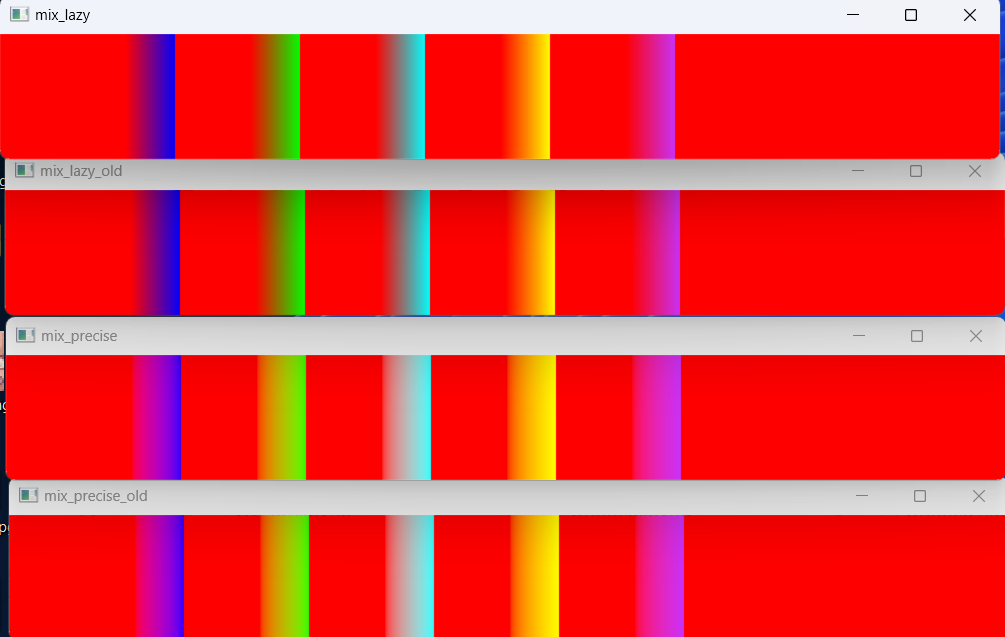Last active
June 30, 2023 10:16
-
-
Save pthom/5155d319a7957a38aeb2ac9e54cc0999 to your computer and use it in GitHub Desktop.
This file contains bidirectional Unicode text that may be interpreted or compiled differently than what appears below. To review, open the file in an editor that reveals hidden Unicode characters.
Learn more about bidirectional Unicode characters
| import numpy as np | |
| import cv2 | |
| def overlay_alpha_image_lazy(background_rgb, overlay_rgba, alpha): | |
| # cf https://en.wikipedia.org/wiki/Alpha_compositing#Alpha_blending | |
| # If the destination background is opaque, then | |
| # out_rgb = overlay_rgb * overlay_alpha + background_rgb * (1 - overlay_alpha) | |
| overlay_alpha = overlay_rgba[: , : , 3].astype(np.float) / 255. * alpha | |
| overlay_alpha_3 = np.dstack((overlay_alpha, overlay_alpha, overlay_alpha)) | |
| overlay_rgb = overlay_rgba[: , : , : 3].astype(np.float) | |
| background_rgb_f = background_rgb.astype(np.float) | |
| out_rgb = overlay_rgb * overlay_alpha_3 + background_rgb_f * (1. - overlay_alpha_3) | |
| out_rgb = out_rgb.astype(np.uint8) | |
| return out_rgb | |
| def overlay_alpha_image_precise(background_rgb, overlay_rgba, alpha, gamma_factor=2.2): | |
| """ | |
| cf minute physics brilliant clip "Computer color is broken" : https://www.youtube.com/watch?v=LKnqECcg6Gw | |
| the RGB values are gamma-corrected by the sensor (in order to keep accuracy for lower luminancy), | |
| we need to undo this before averaging. | |
| """ | |
| overlay_alpha = overlay_rgba[: , : , 3].astype(np.float) / 255. * alpha | |
| overlay_alpha_3 = np.dstack((overlay_alpha, overlay_alpha, overlay_alpha)) | |
| overlay_rgb_squared = np.float_power(overlay_rgba[: , : , : 3].astype(np.float), gamma_factor) | |
| background_rgb_squared = np.float_power( background_rgb.astype(np.float), gamma_factor) | |
| out_rgb_squared = overlay_rgb_squared * overlay_alpha_3 + background_rgb_squared * (1. - overlay_alpha_3) | |
| out_rgb = np.float_power(out_rgb_squared, 1. / gamma_factor) | |
| out_rgb = out_rgb.astype(np.uint8) | |
| return out_rgb | |
| def test_overlay(): | |
| img = np.zeros((100, 800, 3), np.uint8) | |
| img[ : , : , : ] = (0, 0, 255) | |
| overlay = np.zeros((100, 800, 4), np.uint8) | |
| def make_gradient(x0, color): | |
| x1 = x0 + 40 | |
| for x in range(x0, x1): | |
| for y in range(0, 100): | |
| k = (x - x0) / (x1 - x0) | |
| alpha = int(round(k * 255.)) | |
| color_grad = (color[0], color[1], color[2], alpha) | |
| overlay[y, x, :] = color_grad | |
| make_gradient(100, (255, 0, 0)) | |
| make_gradient(200, (0, 255, 0)) | |
| make_gradient(300, (255, 255, 0)) | |
| make_gradient(400, (0, 255, 255)) | |
| make_gradient(500, (250, 50, 200)) | |
| mix_precise = overlay_alpha_image_precise(img, overlay, alpha=1.) | |
| mix_lazy = overlay_alpha_image_lazy(img, overlay, alpha=1.) | |
| cv2.imshow("mix_precise", mix_precise) | |
| cv2.imshow("mix_lazy", mix_lazy) | |
| #cv2.imshow("img", img) | |
| #cv2.imshow("overlay", overlay) | |
| cv2.waitKey() | |
| test_overlay() |
Sign up for free
to join this conversation on GitHub.
Already have an account?
Sign in to comment
nope, did a full-float version and it still looks harsh. guess 40 steps is just not enough. dithering may do something, but meh that's too much work.
doing gamma in 0-255 space is also not a great idea, but
it works out approximately. at leastit always works in cases of a simple power, just not for the more interesting curves like sRGB.sqrt((255 * x1)^2 * (1-a) + (255 * x2)^2 * a) = 255 * sqrt(x1^2 * (1-a) + x2^2 * a). The same does not quite hold for 2.2 (wolfram alpha), though it remains very close.difference is very hard to tell:

new code: